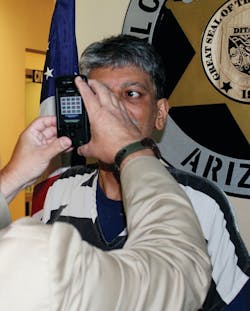2013: A law enforcement odyssey
Police innovators say modern policing reflects both sociological and technological trends coming of age
As times change, so do approaches to policing. From the days of handheld radios the size of bricks, handwritten reports and bulging metal file cabinets housing hundreds of manila case file folders, modern law enforcement has gone digital, biometric and analytical. This isn’t your daddy’s policing anymore.
And these changes are good things, say people like Dale Peet, a former head of the Michigan State Police Intelligence Center and present-day industry consultant for SAS Institute. Peet says he foresees rapid changes in the intrinsic investigatory process used by law enforcement agencies. Here are three trends he believes will have some of the strongest impact on how police work cases:
Social media analytics (SMA) and sentiment analysis tools. Peet says these tools will become increasingly important in canvassing Twitter, Facebook and other social network feeds as an early-warning system for threats on officials, and other potential trouble spots or issues. “Look for automation of the technologies,” predicts Peet, who adds that, “as…massive amounts of data are analyzed, the system is sending alerts to analysts when certain thresholds or business rules are met.”
Confidential informant protocols. It’s not unusual for operations run by multiple agencies involving CIs to not be on the same page. Peet says a future remedy will be developing “tools that provide capabilities that automate multi-jurisdictional de-confliction of informants. Such tools will give law enforcement greater latitude in their use of, and better management options for, confidential informants while reducing the overall risk to the agency when using informants.” The de-confliction of confidential informants among different law enforcement agencies involves getting all the data about a CI in one repository, providing a single view of an informant, while still protecting the CI’s identity.
Revamped management practices. Faced with budget cuts, agencies will work to get more out of their officers, even with outdated technology. Consequently, personnel are being evaluated on their effectiveness and ability to use technology to discover connections and patterns of criminal activity in an effort to disrupt or prevent the actual crime from being committed. “If agencies can forecast the probabilities for criminal activities based on solid data, and thereby disrupt crimes and terrorism, then they can reduce costs across the spectrum,” Peet says.
Peet says most agencies today are not doing true intelligence led policing, but are really doing information led policing. Intelligence led policing is very important if agencies will start doing it.
Thunder road
While Drew Kelley, director of marketing for ProMag Industries/Archangel Manufacturing watches politicians bat around the gun issue in our nation’s capitol, his company is still developing better and more efficient firearms, capable of giving law enforcement an increasing edge.
“There’s much more emphasis on polymer-framed pistols,” Kelley says, noting the big differences in carrying a lightweight weapon that can accommodate more rounds with less weight. “These are relatively comfortable to wear,” he says, adding that carrying a lighter combat load makes it less physically stressful shift for the officer.
He also says that the trend to pack more ammo into lighter weaponry can be a real asset in combat conditions. “As anyone who has been in a firefight knows, ammo is your friend,” Kelley says.
So what exactly is Kelley’s company launching? Here are the stocks Kelley says are poised for introduction at or before press time:
The AAM1A for the M14/M1A rifles (Kelley notes that quite a few agencies are acquiring M14's from DoD for the Tactical Units, although it is his understanding that DoD is shipping these with the full-auto feature disabled;
The AA870SC/AA500SC for the Rem-870 and Moss-500/590 shotguns;
The AA1430 SPARTA for putting a modern pistol-grip stock on the Mini-14/30;
And the new AA700 for the Rem-700 sniper rifle
What else is on the forefront?
Face it: While policies, tactics and firearms continue to evolve, one other aspect of police work is moving faster than a speeding bullet: Technology. From firearms to tablets, smartphones to the software police now use to find and build strong cases against suspects, police are dipping more and more into areas that used to be reserved for science fiction.
What’s on the horizon? In addition to the innovations and changes we’ve already covered, here’s a look at what some top companies have in the works or are already producing:
GT-1
What is it? Patented graffiti detection technology
Company: GraffitiTech, Inc.
What it does: CEO Michael Neeley says for cities plagued by graffiti, this futuristic solution already launched in several cities targeted by graffiti “artists” saves the day. The GT-1 allows real time detection, monitoring and notification of the police whenever this type of vandalism is underway. In the works: A newer version of the product featuring enhanced functionality.
“Within the first week of deployment, our units were responsible for the detection and apprehension of two of the city’s most active vandals,” said Manny Solano, Chief of Police, Watsonville, Cal., Police Department. “Combined, the two suspects were responsible for well over $20,000 in damage in just our city alone. GraffitiTech’s product is well worth the investment and easy to use. The suspects were so surprised, the paint on their hands was still wet.”
Real-Time Crime Center for Proactive Policing
What is it? A method to harness relative data in order to provoke intelligent predictions and targeted counteractions.
Company: Motorola Solutions
What it does: Clint Quanstrom vice president of Motorola’s Integration Services, says “With the Real-Time Crime Center solution from Motorola Solutions, law enforcement officers can now approach an incident armed with more operational intelligence than ever before.” Motorola says the center employs information from multiple data sources such as video, sensors, alarms and computer-aided dispatch (CAD). Records are processed with real-time analytics to deliver one operational view. Advanced public safety analytics deliver intelligent data and video to anticipate crowd formations, recognize faces or detect gunshots to help agencies become more proactive, shortening response times and optimizing resource strategies.
It works by integrating existing agency records and databases with additional resources such as parole, national crime and inspections databases, together with information gleaned from court systems and evidence management to magnify the impact of the analytics engines. Streaming video can be shared between communications centers and responders. This advanced software enables interoperability across public safety, public service and private enterprise video systems as well as analytics to trigger real-time alerts to significantly improve situational awareness.
This force multiplier is available now.
NICE Situator
What is it? A different slant on providing city surveillance centers with real time information about what’s happening and where.
Company: NICE Systems
What it does: Provides real-time alerting to facilitate streamlined responses, improved collaboration and allow better reconstruction of events, post-incident. The NICE Situator consolidates information from many different systems to provide intelligent, real-time alerting and streamlined responses. Citywide video surveillance can be seamlessly combined with public and private video management systems (VMS) and accessed through one interface, allowing surveillance centers to significantly expand their intelligence assets and reach. In addition, gunshot detection, License Plate Recognition (LPR), weather systems, emergency/mass notification, traffic systems, access control, GIS and more can also be integrated.
GIS integration, for example, enables video cameras, sensors, and other assets to be overlaid on the same map to give operators situational awareness and a better visual picture of unfolding situations. Surveillance center personnel receive complete information about events, which they can then manage through one system. Responses are also streamlined through automatic correlation (for example, between gunshot detection and video) and smart resource assignment (based on specific resource attributes such as availability, skills, and location). The NICE Situator also provides operators with step-by-step guided action plans based on pre-defined response procedures. This minimizes the potential for human error.
These systems are currently being rolled out to law enforcement, but are already in use in many U.S. airports, seaports, utilities and other places.
EB Specialized Device Platform (SDP)
What is it? A versatile communications platform targeted to vertical markets.
Company: Elektrobit
What it does: Company Vice President Jani Lyrintzis says the EB SDP based SmartPhones are the first SmartPhone devices to provide a seamless roaming capability between FirstNet and its roaming partners (most likely Verizon and/or AT&T and/or T-Mobile, according to Lyrintzis) while providing the familiar Android user experience and capability to run Android apps. “With the LTE data rates, processing power and memory in the device, the officers can run (a) multitude of data-heavy applications, such as video streaming, and have practically the same connectivity and communications capabilities in their hands, as they have in their patrol vehicles,” says Lyrintzis.
These devices are currently available for demo and field trials.
MORIS Mobile Offender Recognition and Information System
What is it? Mobile biometric information for offender identification geared for smartphone use.
Company: BI-2 Technologies
What it does: Company Pres. Sean Mullin says this technology will allow all levels of law enforcement, as well as military and intelligence organizations, to verify subject identity, criminal backgrounds and certain types of risk information, all with a central database. This Smartphone technology provides iris, fingerprint, and facial recognition identification technology to local law enforcement and public safety officers, ranging from police officers, patrol deputies and detectives to probation and parole officers, and units specializing in serving warrants or handling sex offenders, all from virtually anywhere.
For example, if there is a question about an individual’s identity (such as a subject carrying no identification, or one with conflicting identification) and the individual is stopped, the iris ID will make for positive identification within seconds (along with a time, date, and GPS stamp). Says Mullin, “This can be critically important in situations where the individual is using a different identity to avoid detection for other crimes or risk factors.” Matches takes place through web-based iris, fingerprint and facial biometric databases and networks built and maintained by BI-2 Technologies. State and local agencies enroll suspects at booking.
This groundbreaking technology is now available and already in use in some states.
Outerlink Uniquity
What is it? Satellite-based software that improves and expands an agency’s communications capabilities.
Company: Outerlink Global Solutions
What it does: Company executives, CEO Steve Durante and CTO Rod Danielson say that since law enforcement officers often require the ability to communicate through a highly secure, centralized database, their product, Outerlink Uniquity, will provide a low-cost option that allows mobile communication, regardless of network availability. The software will operate on next-generation, high-bandwidth satellites, and can run on smartphones and tablets, allowing law enforcement officers to communicate through one centralized database. Additionally, it will allow both voice and text communications, as well as the ability to view real-time situational awareness information across multiple domains.
This software should be available in three- to six-months, its release timed to coincide with the availability of the next-generation satellites with which it will operate.



